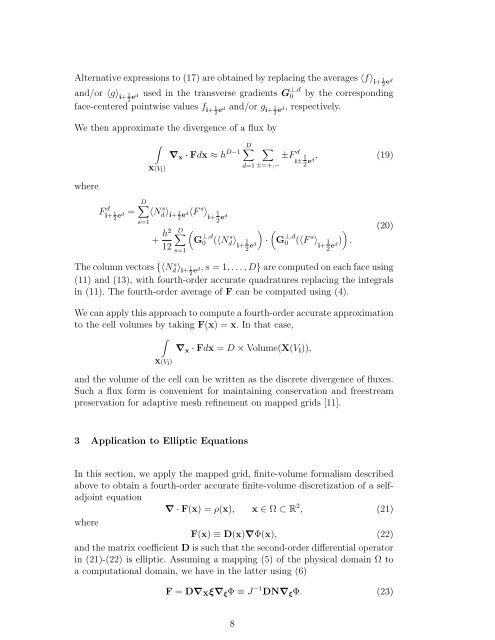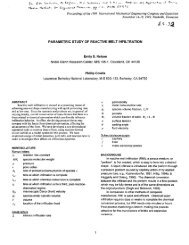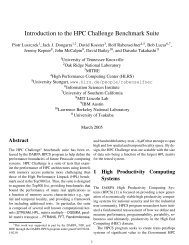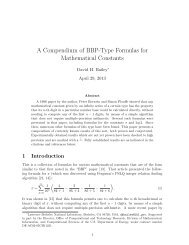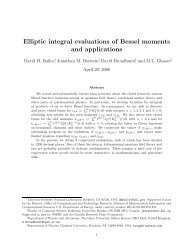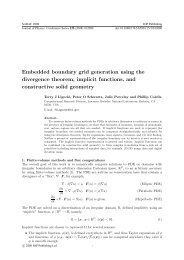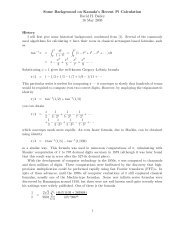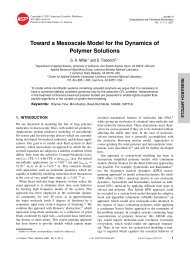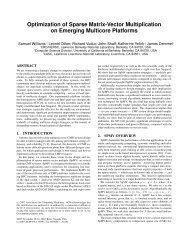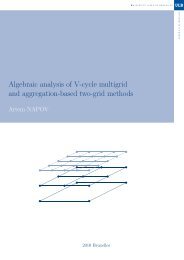High-Order, Finite-Volume Methods in Mapped Coordinates
High-Order, Finite-Volume Methods in Mapped Coordinates
High-Order, Finite-Volume Methods in Mapped Coordinates
You also want an ePaper? Increase the reach of your titles
YUMPU automatically turns print PDFs into web optimized ePapers that Google loves.
Alternative expressions to (17) are obta<strong>in</strong>ed by replac<strong>in</strong>g the averages 〈f〉 i+12 edand/or 〈g〉 i+1 used <strong>in</strong> the transverse gradients G ⊥,d2 ed 0 by the correspond<strong>in</strong>gface-centered po<strong>in</strong>twise values f i+1 and/or g 2 ed i+ 1 ed, respectively.2We then approximate the divergence of a flux bywhere∫X(V i )∇ x · Fdx ≈ h D−1D ∑∑d=1 ±=+,−±F di± 1 (19)ed,2F di+ 1 2 ed =D∑〈Nd〉 s i+1ed〈F s 〉 12 i+s=1+ h2 D∑12s=12 ed()G ⊥,d0 (〈Nd〉 s 1 i+·2 ed()G ⊥,d0 (〈F s 〉 1 i+ ed) .2(20)The column vectors {〈Nd〉 s i+1ed, s = 1, . . . , D} are computed on each face us<strong>in</strong>g2(11) and (13), with fourth-order accurate quadratures replac<strong>in</strong>g the <strong>in</strong>tegrals<strong>in</strong> (11). The fourth-order average of F can be computed us<strong>in</strong>g (4).We can apply this approach to compute a fourth-order accurate approximationto the cell volumes by tak<strong>in</strong>g F(x) = x. In that case,∫∇ x · Fdx = D × <strong>Volume</strong>(X(V i )),X(V i )and the volume of the cell can be written as the discrete divergence of fluxes.Such a flux form is convenient for ma<strong>in</strong>ta<strong>in</strong><strong>in</strong>g conservation and freestreampreservation for adaptive mesh ref<strong>in</strong>ement on mapped grids [11].3 Application to Elliptic EquationsIn this section, we apply the mapped grid, f<strong>in</strong>ite-volume formalism describedabove to obta<strong>in</strong> a fourth-order accurate f<strong>in</strong>ite-volume discretization of a selfadjo<strong>in</strong>tequation∇ · F(x) = ρ(x), x ∈ Ω ⊂ R 2 , (21)whereF(x) ≡ D(x)∇Φ(x), (22)and the matrix coefficient D is such that the second-order differential operator<strong>in</strong> (21)-(22) is elliptic. Assum<strong>in</strong>g a mapp<strong>in</strong>g (5) of the physical doma<strong>in</strong> Ω toa computational doma<strong>in</strong>, we have <strong>in</strong> the latter us<strong>in</strong>g (6)F = D∇ X ξ∇ ξ Φ ≡ J −1 DN∇ ξ Φ. (23)8


